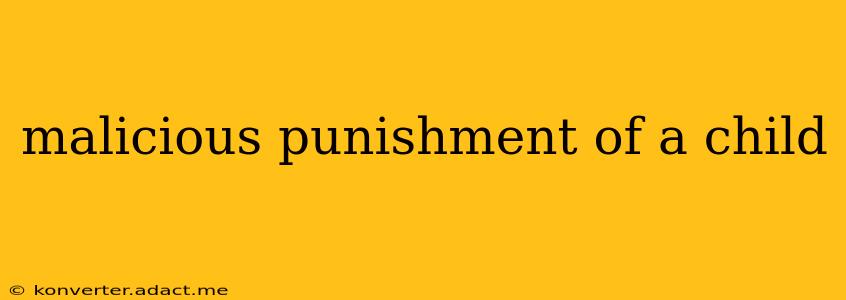Malicious punishment of a child is a serious issue, encompassing any action by a caregiver that intentionally causes harm, suffering, or fear to a child. It's crucial to understand the difference between discipline and abuse, as the line can sometimes be blurry. This article will delve into the various forms malicious punishment can take, its devastating effects on children, and the crucial steps to take if you suspect a child is being harmed.
What Constitutes Malicious Punishment?
Malicious punishment goes beyond reasonable discipline. It's characterized by actions that are excessive, cruel, and intended to inflict pain or humiliation, rather than to teach or correct behavior. This can manifest in many ways, including:
- Physical Abuse: This includes hitting, slapping, kicking, shaking, burning, or any other form of physical violence. The severity can range from a seemingly minor slap to severe beatings resulting in serious injury.
- Emotional Abuse: This involves constant criticism, belittling, rejection, threats, intimidation, or manipulation. It can also include isolating the child from friends and family. The long-term effects of emotional abuse can be deeply damaging.
- Neglect: While not always intentional harm, neglect is a form of malicious punishment when it stems from a deliberate disregard for a child's basic needs, such as food, shelter, clothing, medical care, and emotional support. This can be just as devastating as physical abuse.
- Sexual Abuse: Any sexual act imposed on a child is inherently abusive and malicious. This includes touching, fondling, rape, exploitation, and exposure to pornography. The psychological consequences can be lifelong.
How to Identify Malicious Punishment: Red Flags
Recognizing malicious punishment can be challenging, especially when caregivers are skilled at hiding their actions. However, some common red flags include:
- Unexplained injuries: Bruises, cuts, burns, or other injuries that are inconsistent with the explanation given.
- Changes in behavior: A child who becomes withdrawn, fearful, anxious, aggressive, or exhibits sudden changes in school performance.
- Fear of adults: A child who shows excessive fear or avoidance of specific adults, especially caregivers.
- Self-harm: Children who engage in self-harm may be exhibiting a response to prolonged abuse or neglect.
- Inappropriate sexual knowledge or behavior: This could be an indicator of sexual abuse.
What are the Long-Term Effects of Malicious Punishment?
The consequences of malicious punishment on a child can be severe and long-lasting, impacting their physical, emotional, and psychological well-being. These effects can include:
- Physical injuries: ranging from minor bruises to severe, life-threatening injuries.
- Mental health issues: Depression, anxiety, post-traumatic stress disorder (PTSD), and other mental health disorders.
- Behavioral problems: Aggression, delinquency, substance abuse, and difficulty forming healthy relationships.
- Difficulties in school: Poor academic performance, difficulty concentrating, and social difficulties.
- Low self-esteem: A sense of worthlessness and hopelessness.
Is spanking ever okay? What is considered reasonable discipline?
The question of whether spanking is ever acceptable is a highly debated topic. Many child development experts strongly advise against any form of physical punishment, emphasizing the importance of positive discipline techniques that focus on teaching and guiding children, rather than inflicting pain. Reasonable discipline involves setting clear expectations, providing consistent consequences, and offering positive reinforcement for good behavior.
What should I do if I suspect a child is being maliciously punished?
If you suspect a child is being maliciously punished, it's crucial to take action. Here are some steps you can take:
- Report your concerns: Contact child protective services or the authorities in your area.
- Document the abuse: Keep a record of any incidents you witness or hear about, including dates, times, and details.
- Seek support: Talk to a trusted friend, family member, or therapist.
Protecting children from malicious punishment is a collective responsibility. By understanding the signs, taking action when necessary, and promoting positive parenting techniques, we can create safer and healthier environments for children to thrive.
